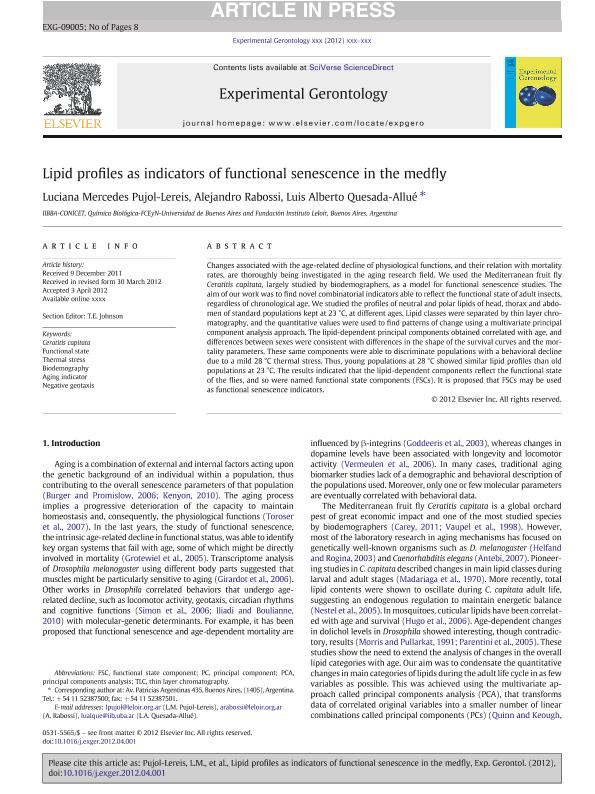Artículo
Lipid profiles as indicators of functional senescence in the medfly
Fecha de publicación:
06/2012
Editorial:
Elsevier
Revista:
Experimental Gerontology
ISSN:
0531-5565
e-ISSN:
1873-6815
Idioma:
Inglés
Tipo de recurso:
Artículo publicado
Clasificación temática:
Resumen
Changes associated with the age-related decline of physiological functions, and their relation with mortality rates, are thoroughly being investigated in the aging research field. We used the Mediterranean fruit fly Ceratitis capitata, largely studied by biodemographers, as a model for functional senescence studies. The aim of our work was to find novel combinatorial indicators able to reflect the functional state of adult insects, regardless of chronological age. We studied the profiles of neutral and polar lipids of head, thorax and abdomen of standard populations kept at 23 °C, at different ages. Lipid classes were separated by thin layer chromatography, and the quantitative values were used to find patterns of change using a multivariate principal component analysis approach. The lipid-dependent principal components obtained correlated with age, and differences between sexes were consistent with differences in the shape of the survival curves and the mortality parameters. These same components were able to discriminate populations with a behavioral decline due to a mild 28 °C thermal stress. Thus, young populations at 28 °C showed similar lipid profiles than old populations at 23 °C. The results indicated that the lipid-dependent components reflect the functional state of the flies, and so were named functional state components (FSCs). It is proposed that FSCs may be used as functional senescence indicators.
Archivos asociados
Licencia
Identificadores
Colecciones
Articulos(IIBBA)
Articulos de INST.DE INVEST.BIOQUIMICAS DE BS.AS(I)
Articulos de INST.DE INVEST.BIOQUIMICAS DE BS.AS(I)
Citación
Pujol Lereis, Luciana Mercedes; Rabossi, Alejandro; Quesada Allue, Luis Alberto; Lipid profiles as indicators of functional senescence in the medfly; Elsevier; Experimental Gerontology; 47; 6; 6-2012; 465-472
Compartir
Altmétricas




